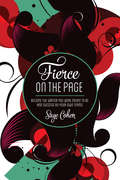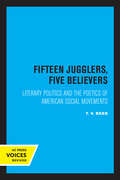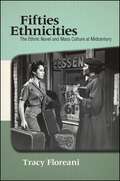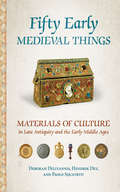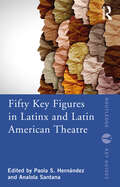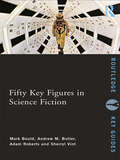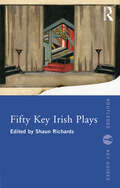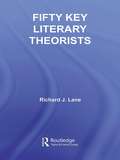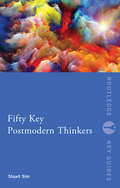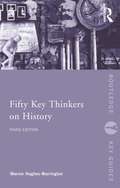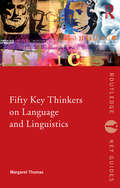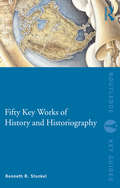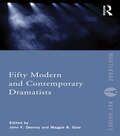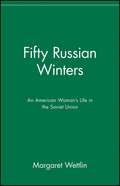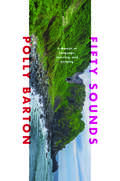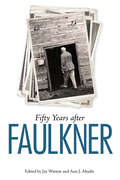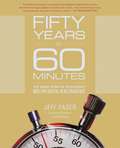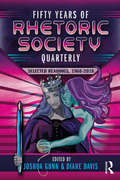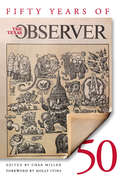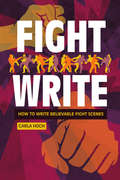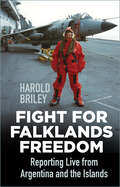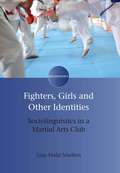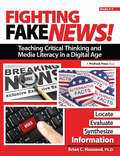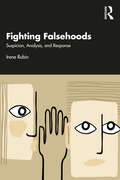- Table View
- List View
Fierce on The Page: Become the Writer You Were Meant to Be and Succeed on Your Own Terms
by Sage CohenProduce your best work. Live your best life. Make your greatest impact. You have everything you need--and you are everything you need--to do the writing you are meant to do. And yet the path to success can be difficult to find and follow. Veteran author and writing guide Sage Cohen believes that ferocity is your best compass for finding your true way forward. She shows you how to transform your attitude and practices so you can:Unleash your creativityCultivate your strengthsOvercome resistance, fear, and other obstaclesDefine success on your own termsMove intentionally toward your goalsBecome unstoppable in your evolutionIn this collection of contemplative and inspiring essays, you'll unlock the secrets to naming your deepest desires, eliminating the challenges that hold you back, and committing to your practice. Fierce on the Page is your trustworthy companion for crafting your best writing and your best life. Join the conversation about the fierce writing life at fierceonthepage.com.
Fifteen Jugglers, Five Believers: Literary Politics and the Poetics of American Social Movements (The New Historicism: Studies in Cultural Poetics #22)
by T. V. ReedT. V. Reed urges an affiliation between literary theory and political action—and between political action and literary theory. What can the "new literary theory" learn from "new social movements," and what can social activists learn from poststructuralism, new historicism, feminist theory, and neomarxism? In striking interpretations of texts in four different genres—James Agee and Walker Evans’s Let Us Now Praise Famous Men, Ralph Ellison's Invisible Man, Norman Mailer's Armies of the Night, and the ecofeminist Women's Pentagon Actions of the early 1980s—Reed shows how reading literary texts for their political strategies and reading political movements as texts can help us overcome certain rhetorical traps that have undermined American efforts to combat racism, sexism, and economic inequality. This title is part of UC Press's Voices Revived program, which commemorates University of California Press’s mission to seek out and cultivate the brightest minds and give them voice, reach, and impact. Drawing on a backlist dating to 1893, Voices Revived makes high-quality, peer-reviewed scholarship accessible once again using print-on-demand technology. This title was originally published in 1992.
Fifties Ethnicities: The Ethnic Novel and Mass Culture at Midcentury (SUNY series in Multiethnic Literatures)
by Tracy FloreaniFifties Ethnicities brings together a variety of texts to explore what it meant to be American in the middle of "America's Century." In a series of comparative readings that draws on novels, television programs, movie magazines, and films, Tracy Floreani crosses generic boundaries to show how literature and mass media worked to mold concepts of ethnicity in the 1950s. Revisiting well-known novels of the period, such as Vladimir Nabokov's Lolita and Ralph Ellison's Invisible Man, as well as less-studied works, such as William Saroyan's Rock Wagram and C. Y. Lee's The Flower Drum Song (the original source of the more famous Rodgers and Hammerstein musical), Floreani investigates how the writing of ethnic identity called into question the ways in which signifiers of Americanness also inherently privileged whiteness. By putting these novels into conversation with popular media narratives such as I Love Lucy, the author offers an in-depth examination of the boundaries and possibilities for participating in American culture in an era that greatly influenced national ideas about identity. While midcentury mass media presented an undeniably engaging vision of American success, national belonging, and guidelines for cultural citizenship, Floreani argues that minority writers and artists were, at the same time, engaging that vision and implicitly participating in its construction.
Fifty Early Medieval Things: Materials of Culture in Late Antiquity and the Early Middle Ages
by Paolo Squatriti Deborah Deliyannis Hendrik DeyFifty Early Medieval Things introduces readers to the material culture of late antique and early medieval Europe, north Africa, and western Asia. Ranging from Iran to Ireland and from Sweden to Tunisia, Deborah Deliyannis, Hendrik Dey, and Paolo Squatriti present fifty objects—artifacts, structures, and archaeological features—created between the fourth and eleventh centuries, an ostensibly "Dark Age" whose cultural richness and complexity is often underappreciated. Each thing introduces important themes in the social, political, cultural, religious, and economic history of the postclassical era. Some of the things, like a simple ard (plow) unearthed in Germany, illustrate changing cultural and technological horizons in the immediate aftermath of Rome's collapse; others, like the Arabic coin found in a Viking burial mound, indicate the interconnectedness of cultures in this period. Objects such as the Book of Kells and the palace-city of Anjar in present-day Jordan represent significant artistic and cultural achievements; more quotidian items (a bone comb, an oil lamp, a handful of chestnuts) belong to the material culture of everyday life. In their thing-by-thing descriptions, the authors connect each object to both specific local conditions and to the broader influences that shaped the first millennium AD, and also explore their use in modern scholarly interpretations, with suggestions for further reading. Lavishly illustrated and engagingly written, Fifty Early Medieval Things demonstrates how to read objects in ways that make the distant past understandable and approachable.
Fifty Key Figures in LatinX and Latin American Theatre (Routledge Key Guides)
by Paola S HernándezFifty Key Figures in Latinx and Latin American Theatre is a critical introduction to the most influential and innovative theatre practitioners in the Americas, all of whom have been pioneers in changing the field. The chosen artists work through political, racial, gender, class, and geographical divides to expand our understanding of Latin American and Latinx theatre while at the same time offering a space to discuss contested nationalities and histories. Each entry considers the artist’s or collective’s body of work in its historical, cultural, and political context and provides a brief biography and suggestions for further reading. The volume covers artists from the present day to the 1960s—the emergence of a modern theatre that was concerned with Latinx and Latin American themes distancing themselves from an European approach. A deep and enriching resource for the classroom and individual study, this is the first book that any student of Latinx and Latin American theatre should read.
Fifty Key Figures in Science Fiction (Routledge Key Guides)
by Adam Roberts Mark Bould Sherryl Vint Andrew M. ButlerFifty Key Figures in Science Fiction is a collection of engaging essays on some of the most significant figures who have shaped and defined the genre. Diverse groups within the science fiction community are represented, from novelists and film makers to comic book and television writers. Important and influential names discussed include: Octavia Butler George Lucas Robert Heinlein Gene Roddenberry Stan Lee Ursula K. Le Guin H.G. Wells This outstanding reference guide charts the rich and varied landscape of science fiction and includes helpful and up-to-date lists of further reading at the end of each entry. Available in an easy to use A-Z format, Fifty Key Figures in Science Fiction will be of interest to students of Literature, Film Studies, and Cultural Studies.
Fifty Key Irish Plays (Routledge Key Guides)
by Shaun RichardsFifty Key Irish Plays charts the progression of modern Irish drama from Dion Boucicault’s entry on to the global stage of the Irish diaspora to the contemporary dramas created by the experiences of the New Irish. Each chapter provides a brief plot outline along with informed analysis and, alert to the cultural and critical context of each play, an account of the key roles that they played in the developing story of Irish drama. While the core of the collection is based on the critical canon, including work by J. M. Synge, Lady Gregory, Teresa Deevy, and Brian Friel, plays such as Tom Mac Intyre’s The Great Hunger and ANU Productions’ Laundry, which illuminate routes away from the mainstream, are also included. With a focus on the development of form as well as theme, the collection guides the reader to an informed overview of Irish theatre via succinct and insightful essays by an international team of academics. This invaluable collection will be of particular interest to undergraduate students of theatre and performance studies and to lay readers looking to expand their appreciation of Irish drama.
Fifty Key Literary Theorists (Routledge Key Guides)
by Richard J. LaneCovering over a century's worth of debate, thinking and writing about literature, this is a unique guide to the lives and works of fifty theorists who have left an indelible mark on literary studies. Featuring theorists such as Judith Butler, Jacques Derrida, Sigmund Freud and Edward Said, this accessible guide includes: a glossary of terms full cross-referencing for maximum ease of use authoritative guides to further reading on and by each theorist. An essential resource for all students of literature, Fifty Key Literary Theorists explores the gamut of critical debate, from the New Critics to the Deconstructionists, and from post-colonialism to post-Marxism and more.
Fifty Key Postmodern Thinkers: Fifty Key Postmodern Thinkers (Routledge Key Guides)
by Stuart SimPostmodernism is an important part of the cultural landscape which continues to evolve, yet the ideas and theories surrounding the subject can be diverse and difficult to understand. Fifty Postmodern Thinkers critically examines the work of fifty of the most important theorists within the postmodern movement who have defined and shaped the field, bringing together their key ideas in an accessible format. Drawing on figures from a wide range of subject areas including literature, cultural theory, philosophy, sociology and architecture those covered include: John Barth Umberto Eco Slavoj Zizek Cindy Sherman John Cage Jean-Francois Lyotard Charles Jencks Jacques Derrida Homi K. Bhabha Quentin Tarantino Each entry examines the thinkers’ career, key contributions and theories and refers to their major works. A valuable resource for those studying postmodern ideas at both undergraduate and postgraduate level, this text will appeal across the humanities and social sciences.
Fifty Key Thinkers on History (Routledge Key Guides)
by Marnie Hughes-WarringtonFifty Key Thinkers on History is an essential guide to the most influential historians, theorists and philosophers of history. The entries offer comprehensive coverage of the long history of historiography ranging from ancient China, Greece and Rome, through the Middle Ages to the contemporary world. This third edition has been updated throughout and features new entries on Machiavelli, Ranajit Guha, William McNeil and Niall Ferguson. Other thinkers who are introduced include: Herodotus Bede Ibn Khaldun E. H. Carr Fernand Braudel Eric Hobsbawm Michel Foucault Edward Gibbon Each clear and concise essay offers a brief biographical introduction; a summary and discussion of each thinker’s approach to history and how others have engaged with it; a list of their major works and a list of resources for further study.
Fifty Key Thinkers on Language and Linguistics (Routledge Key Guides)
by Margaret ThomasWhat was the first language, and where did it come from? Do all languages have properties in common? What is the relationship of language to thought? Fifty Key Thinkers on Language and Linguistics explores how fifty of the most influential figures in the field have asked and have responded to classic questions about language. Each entry includes a discussion of the person’s life, work and ideas as well as the historical context and an analysis of his or her lasting contributions. Thinkers include: Aristotle Samuel Johnson Friedrich Max Müller Ferdinand de Saussure Joseph H. Greenberg Noam Chomsky Fully cross-referenced and with useful guides to further reading, this is an ideal introduction to the thinkers who have had a significant impact on the subject of Language and Linguistics.
Fifty Key Works of History and Historiography (Routledge Key Guides)
by Kenneth R. StunkelFifty Key Works of History and Historiography introduces some of the most important works ever written by those who have sought to understand, capture, query and interpret the past. The works covered include texts from ancient times to the present day and from different cultural traditions ensuring a wide variety of schools, methods and ideas are introduced. Each of the fifty texts represents at least one of six broad categories: early examples of historiography (e.g. Herodotus and Augustine) non-western works (e.g. Shaddad and Fukuzawa) ‘Critical’ historiography (e.g. Mabillon and Ranke) history of minorities, neglected groups or subjects (e.g. Said and Needham) broad sweeps of history (e.g. Mumford and Hofstadter) problematic or unconventional historiography (e.g. Foucault and White). Each of the key works is introduced in a short essay written in a lively and engaging style which provides the ideal preparation for reading the text itself. Complete with a substantial introduction to the field, this book is the perfect starting point for anyone new to the study of history or historiography.
Fifty Modern and Contemporary Dramatists (Routledge Key Guides)
by Maggie B. Gale John F. DeeneyFifty Modern and Contemporary and Dramatists is a critical introduction to the work of some of the most important and influential playwrights from the 1950s to the present day. The figures chosen are among the most widely studied by students of drama, theatre and literature and include such celebrated writers as: • Samuel Beckett • Caryl Churchill • Anna Deavere Smith • Jean Genet • Sarah Kane • Heiner Müller • Arthur Miller • Harold Pinter • Sam Shephard Each short essay is written by one of an international team of academic experts and offers a detailed analysis of the playwright’s key works and career. The introduction provides an historical and theatrical context to the volume, which provides an invaluable overview of modern and contemporary drama.
Fifty Russian Winters: An American Woman's Life in the Soviet Union
by Margaret WettlinFIFTY RUSSIAN WINTERS In 1932 Margaret Wettlin left Depression-torn America for the Soviet Union, eager to see for herself if communism was the hope for the future. Planning to remain one year, she fell in love with and married stage director Andrei Efremoff, and stayed on for almost fifty years. This extraordinary memoir is the story of how she and her family-and millions of their fellow citizens-struggled to survive the hardships of famine, repression, war, and terrible purges. Fifty Russian Winters is an incomparable and moving document-the only close-up view we have of Soviet life by an American who spent more than half a lifetime inside Russia and who, as Harrison Salisbury says in his introduction, "kept her heart and mind and eyes open-and remembered."
Fifty Sounds: A Memoir of Language, Learning, and Longing
by Polly BartonFor anyone who has ever yearned to master a new language, Fifty Sounds is a visionary personal account and an indispensable resource for learning to think beyond your mother tongue. “The language learning I want to talk about is sensory bombardment. It is a possession, a bedevilment, a physical takeover,” writes Polly Barton in her eloquent treatise on this profoundly humbling and gratifying act. Shortly before graduating with a degree in philosophy from the University of Cambridge, Barton on a whim accepted an English-teaching position in Japan. With the characteristic ambivalence of a twenty-one-year-old whose summer—and life—stretched out almost infinitely before her, she moved to a remote island in the Sea of Japan, unaware that this journey would come to define not only her career but her very understanding of her own identity. Divided into fifty onomatopoeic Japanese phrases, Fifty Sounds recounts Barton’s path to becoming a literary translator fluent in an incredibly difficult vernacular. From “min-min,” the sound of air screaming, to “jin-jin,” the sound of being touched for the first time, Barton analyzes these and countless other foreign sounds and phrases as a means of reflecting on various cultural attitudes, including the nuances of conformity and the challenges of being an outsider in what many consider a hermetically sealed society. In a tour-de-force of lyrical, playful prose, Barton recalls the stifling humidity that first greeted her on the island along with the incessant hum of peculiar new noises. As Barton taught English to inquisitive middle school children, she studied the basics of Japanese in an inverse way, beginning with simple nouns and phrases, such as “cat,” “dog,” and “Hello, my name is.” But when it came to surrounding herself in the culture, simply mastering the basics wasn’t enough. Japanese, Barton learned, has three scripts: the phonetic katakana and hiragana (collectively known as kana) and kanji (characters of Chinese origin). Despite her months-long immersion in the language, a word would occasionally produce a sinking feeling and send her sifting through her dictionaries to find the exact meaning. But this is precisely how Barton has come to define language learning: “It is the always-bruised but ever-renewing desire to draw close: to a person, a territory, a culture, an idea, an indefinable feeling.” Engaging and penetrating, Fifty Sounds chronicles everything from Barton’s most hilarious misinterpretations to her new friends and lovers in Tokyo —and even the influence of Ludwig Wittgenstein’s transformative philosophy. A classic in the making in the tradition of Anne Carson and Rachel Cusk, Fifty Sounds is a celebration of the empowering act of learning to communicate in any new language.
Fifty Years after Faulkner (Faulkner and Yoknapatawpha Series)
by Jay Watson and Ann J. AbadieContributions by Ted Atkinson, Michael P. Bibler, Deborah Clarke, David A. Davis, David M. Earle, Jason D. Fichtel, Elizabeth Fielder, Joseph Fruscione, Matthew Pratt Guterl, Patrick E. Horn, Cheryl Lester, Jessica Martell, Sharon Monteith, Richard C. Moreland, Alan Nadel, Julie Beth Napolin, François Pitavy, Ramón Saldívar, Hortense J. Spillers, Terrell L. Tebbetts, Zackary Vernon, Randall Wilhelm, and Charles Reagan Wilson These essays examine issues across the wide arc of Faulkner's extraordinary career, from his aesthetic apprenticeship in the visual arts, to late-career engagements with the Cold War, the civil rights movement, and beyond, to the place of death in his artistic vision and the long, varied afterlives he and his writings have enjoyed in literature and popular culture. Contributors deliver stimulating reassessments of Faulkner's first novel, Soldiers' Pay; his final novel, The Reivers; and much of the important work between. Scholars explore how a broad range of elite and lowbrow cultural forms—plantation diaries, phonograph records, pulp magazines—shaped Faulkner's capacious imagination and how his works were translated into such media as film and modern dance. Essays place Faulkner's writings in dialogue with those of fellow twentieth-century authors including W. E. B. Du Bois, Ernest Hemingway, Richard Hall, and Jayne Anne Phillips; locate his work in relation to African American intellectual currents and Global South artistic traditions; and weigh the rewards as well as the risks of dislodging Faulkner from the canonical position he currently occupies. While Faulkner studies has cultivated an image of the novelist as a neglected genius who toiled in obscurity, a look back fifty years to the final months of the author's life reveals a widely traveled and celebrated artist whose significance was framed in national and international as well as regional terms. Fifty Years after Faulkner bears out that expansive view, reintroducing us to a writer whose work retains its ability to provoke, intrigue, and surprise a variety of readerships.
Fifty Years of 60 Minutes: The Inside Story of Television's Most Influential News Broadcast
by Jeff FagerThe ultimate inside story of 60 Minutes, the program that has tracked and shaped the biggest moments in post-war American history.From its almost accidental birth in 1968, 60 Minutes has set the standard for broadcast journalism, joining us in our living rooms each Sunday night to surprise us about the world. The show has profiled every major leader, artist, and movement of the past five decades, perfecting the news-making interview and inventing the groundbreaking TV expose. From legendary sit-downs with Richard Nixon in 1968 (in which he promised “to restore respect to the presidency”) and Bill Clinton in 1992 (after the first revelations of infidelity) to landmark investigations into the tobacco industry, Lance Armstrong’s doping, and the torture of prisoners in Abu-Ghraib, the broadcast has not just reported on our world but changed it too. Now, Executive Producer Jeff Fager pulls back the curtain on how this remarkable journalism is done, taking the reader into the editing room with the show’s brilliant producers and beloved correspondents, including hard-charging Mike Wallace, writer’s-writer Morley Safer, soft-but-tough Ed Bradley, relentless Lesley Stahl, ace interviewer Charlie Rose, tireless Anderson Cooper, intrepid Scott Pelley, and illuminating storyteller Steve Kroft. He details the decades of human drama that have made the show’s success possible: the ferocious (and encouraged) competition between correspondents, the door slamming, the risk-taking, and the pranks. Fager takes on the program’s mistakes and describes what it learned from them. Above all, he reveals the essential tenets that have never changed: why founder Don Hewitt believed “hearing” a story is more important than seeing it, why the “small picture” is the best way to illuminate a larger one, and why the most memorable stories are almost always those with a human being at the center. At once a sweeping portrait of fifty years of American cultural history and an intimate look at how the news gets made, Fifty Years of 60 Minutes shares the secret of what’s made the nation’s favorite TV program exceptional for all these years.
Fifty Years of Rhetoric Society Quarterly: Selected Readings, 1968-2018
by Diane Davis Joshua GunnFifty Years of Rhetoric Society Quarterly: Selected Readings, 1968-2018 celebrates the semicentennial of Rhetoric Society Quarterly, bringing together the most influential essays included in the journal over the past fifty years. Assessed by members of the Rhetoric Society of America, this collection provides advanced undergraduate and graduate students with a balanced perspective on rhetorical theory and practice from scholars in both communication studies and rhetoric and writing studies. The volume covers a range of themes, from the history of rhetorical studies, writing and speaking pedagogy, and feminism, to the work of Kenneth Burke, the rhetoric of science, and rhetorical agency.
Fifty Years of the Texas Observer
by Molly Ivins Char MillerFor the past five decades the Texas Observer has been an essential voice in Texas culture and politics, championing honest government, civil rights, labor, and the environment, while providing a platform for many of the state's most passionate and progressive voices. Included are ninety-one selections from Roy Bedichek, Lou Dubose, Ronnie Dugger, Dagoberto Gilb, Jim Hightower, Molly Ivins, Larry McMurtry, Maury Maverick Jr., Willie Morris, Debbie Nathan, and others.To mark the Observer's fiftieth anniversary, Char Miller has selected a cross section of the best work to appear in its pages. Not only does the collection pay homage to an important alternative voice in Texas journalism, it also serves as a progressive chronicle of a half-century of life in the Lone Star State-a state that has spawned three presidents in the last forty years. If Texas is, as some say, a crucible for national politics, then Fifty Years of the Texas Observer can be read as a casebook for issues that concern citizens in all fifty states.Molly Ivins's foreword gives historical background for the Observer and sets the stage for the book.
Fifty Years of the Texas Observer
by Molly Ivins Char MillerFor the past five decades the Texas Observer has been an essential voice in Texas culture and politics, championing honest government, civil rights, labor, and the environment, while providing a platform for many of the state's most passionate and progressive voices. Included are ninety-one selections from Roy Bedichek, Lou Dubose, Ronnie Dugger, Dagoberto Gilb, Jim Hightower, Molly Ivins, Larry McMurtry, Maury Maverick Jr., Willie Morris, Debbie Nathan, and others.To mark the Observer's fiftieth anniversary, Char Miller has selected a cross section of the best work to appear in its pages. Not only does the collection pay homage to an important alternative voice in Texas journalism, it also serves as a progressive chronicle of a half-century of life in the Lone Star State-a state that has spawned three presidents in the last forty years. If Texas is, as some say, a crucible for national politics, then Fifty Years of the Texas Observer can be read as a casebook for issues that concern citizens in all fifty states.Molly Ivins's foreword gives historical background for the Observer and sets the stage for the book.
Fight Write: How to Write Believable Fight Scenes
by Carla HochWhether a side-street skirmish or an all-out war, fight scenes bring action to the pages of every kind of fiction. But a poorly done or unbelievable fight scene can ruin a great book in an instant. In Fight Write you'll learn practical tips, terminology, and the science behind crafting realistic fight scenes for your fiction. Broken up into "Rounds," trained fighter and writer Carla Hoch guides you through the many factors you'll need to consider when developing battles and brawls.In Round 1, you will consider how the Who, When, Where, and Why questions affect what type of fight scene you want to craft.Round 2 delves into the human factors of biology (think fight or flight and adrenaline) and psychology (aggression and response to injuring or killing another person).Round 3 explores different fighting styles that are appropriate for different situations: How would a character fight from a prone position versus being attacked in the street? What is the vocabulary used to describe these styles?Round 4 considers weaponry and will guide you to select the best weapon for your characters, including nontraditional weapons of opportunity, while also thinking about the nitty-gritty details of using them.In Round 5, you'll learn how to accurately describe realistic injuries sustained from the fights and certain weapons, and what kind of injuries will kill a character or render them unable to fight further.By taking into account where your character is in the world, when in history the fight is happening, what the character's motivation for fighting is, and much more, you'll be able write fight scenes unique to your plot and characters, all while satisfying your reader's discerning eye.
Fight for Falklands Freedom: Reporting Live from Argentina and the Islands
by Harold Briley‘Journalists are said to write the first rough drafts of history. But I was only the messenger.’When Argentine troops surged onto the shores of the Falkland Islands, it was Harold Briley who broke the news to Britain and the rest of the world. As the BBC World Service’s Latin America Correspondent, he was perfectly placed both metaphorically and physically: not only was he reporting from his base in Buenos Aires, but he had first-hand knowledge of the countries, their politics and their cultures.In Fight for Falklands Freedom: Reporting Live from Argentina and the Islands, Briley returns to the Islands to tell the full story in a breathless play-by-play account. Drawing on hundreds of his own reports, as well as interviews with political and military leaders from both sides, this is a fascinating insight into what happened, when it happened – and why.
Fighters, Girls and Other Identities
by Lian Malai MadsenThis book examines how young people at a martial arts club in an urban setting participate and interact in a recreational social community. The author relates analyses of their interactions to discussions of relevance to the sociology of sports, anthropology and education, ultimately providing an analytically nuanced contribution to the study of contemporary sociolinguistic processes and identity practices. The author explores how the young participants negotiate their place in the social order, create and maintain friendship groups and relate to different social categories using the ecological descriptions provided by linguistic ethnography. The book will appeal to researchers of discourse analysis, sociolinguistics, sport sociology, extra-curricular education and anthropology.
Fighting Fake News! Teaching Critical Thinking and Media Literacy in a Digital Age: Grades 4-6
by Brian HousandEducators have long struggled to teach students to be critical consumers of the information that they encounter. This struggle is exacerbated by the amount of information available thanks to the Internet and mobile devices. Students must learn how to determine whether or not the information they are accessing is reputable. Fighting Fake News! focuses on applying critical thinking skills in digital environments while also helping students and teachers to avoid information overload. According to a 2017 Pew Research report, we are now living in a world where 67% of people report that they get their “news” from social media. With the lessons and activities in this book, students will be challenged to look at the media they encounter daily to learn to deepen and extend their media literacy and critical thinking skills. Now more than ever, teachers need the instruction in Fighting Fake News! to teach students how to locate, evaluate, synthesize, and communicate information.Grades 4-6
Fighting Falsehoods: Suspicion, Analysis, and Response
by Irene RubinThis book offers the reader tools to recognize, analyze, and fight back against the fake news, misinformation, and disinformation that come at us from every corner. This volume: Uses real, lively examples to help readers detect fake news, false claims, suspicious information/data, biased reporting, and hate speech; Demonstrates through case studies where to look for information, what to look for, how to analyze the logic/illogic involved, and uncover the truth value of a story; Discusses fact-checking sites, what they examine, and their reliability; Provides examples and analyzes the components, purposes, and consequences of conspiracy theories; Illustrates the tricks of using numbers/data to mislead readers; Explains what to look for to help decide whether to believe the conclusions of stories based on surveys; Offers a range of concrete, effective responses to dangerous, exaggerated, distorted, and false narratives; Examines policy responses to fake news, disinformation, and misinformation across the world. A key manual to negotiate the information age, this book will be essential reading for students, scholars, and professionals of journalism and mass communication, public policy, politics, and the social sciences. It will also be an indispensable handbook for the lay reader.
